#Hinduism outside india
Explore tagged Tumblr posts
Photo

Balinese mask
336 notes
·
View notes
Text
the way sanghis will cry hinduphobia at any criticism of the indian government but have nothing to say commodification and bastardization of hinduism and hindu spiritualism in the west. like you guys only bring up hinduphobia to suck narendra modi’s toes and silence anyone who doesn’t agree with you.
#exposing myself as an nri with this one. sorry everyone#but the way hindutvas only bring up hinduphobia to justify their own bigotry#and not examine any of their biases.#like even now if they suddenly start caring about cultural appropriation#they won’t outside of their own agenda. it’s just gonna fuel the victim complex#sigh. i’m tired#anti hindutva#desi tag#desiblr#hinduism#india
13 notes
·
View notes
Text
Was v lucky to get to see a screening of a new documentary about casteism and brahmanical patriarchy in India but also I’m supposed to be discussing it in class later and if I’m being honest the fact that the last ten minutes of the film were basically one big advertisement for Hindus to convert to Buddhism means I’m like hmm well I do have some stuff I could say about this but I don’t want to overreach
#idk I just. look. not my area of expertise#but it piques something in my brain#seeing hinduism as inherently reinforcing and originating hegemony and buddhism as inehrnetky egalitarian#bc you can only make those arguments when hinduism is the majority and buddhism a minority#and again I get why this is like. an argument being made I get how it relates to Ambedkar’s influence I understand that#but also idk there’s a lot of people in Buddhist majority countries who would really disagree w seeing buddhism as inherently egalitarian#and somehow invulnerable to participating in violent power structures#also I would’ve liked to see more input from other religious minorities in India in the documentary#one guy talked about his experience being Muslim and that was it#I don’t think they interviewed any Sikhs or Jains#also idk having the perspective of someone studying judaism—#I was surprised at the idea of just throwing away an entire religion bc its origins had problematic elements#that’s really hard for me to conceptualize tbh.#bc I feel like judaism’s approach is so… its like. the flaws in something don’t make you love it less#picking apart Torah is like. itself an act of worship and study.#like something being flawed can actually make you love it More bc it means you get to dissect it#and that is an act of love#again I mean. lmk if I overstepped anywhere.#I do understand a lot of the context.#although I might sound silly talking about it as an outsider#I get that this is not just a philosophical discussion to people and is in fact a hugely complicated thing with very very high stakes#for people’s lives#and I appreciated how informative the documentary was#I really enjoyed the look into Dalit feminist circles especially#esp bc they’re so often given zero media coverage or attention#I would def recommend the film to people just for that
2 notes
·
View notes
Text
another weirdly sentimental interesting passage from early Naipaul is this bit he has—-the Hindus in Trinidad, with a long history, had adapted their own traditions, one of which was the declaration that a local river *was* the equivalent of Ganga, and so they did all the rites there. One thing I value in early Naipaul is that he’s not a romantic: the preservation of Brahminism is a part of this.
But after India’s independence, with greater trade, suddenly Hindus in Trinidad simply give it up, over night, centuries of history and practice—-why? Well, the real Ganga is in India, and you can import the water now.
#this is how naipaul puts it anyway#the utter centrality of India as a nation to the concept of Hinduism isn’t talked about much#if you’re outside that you either aspire to it or you go to hell. simple as
22 notes
·
View notes
Text

Benefits of professional synopsis writing services
Contact us: 6268991983
0 notes
Text

miku as my babaylan oc who is trans
babaylan research dump (mostly from memory so it’s gonna be pretty distilled):
babaylans are the lead shamans of indigenous filipino tribes (mostly northside, the luzon and visayas area, rip mindanao) that are responsible for practically every spiritual aspect of the community. only women were allowed to be babaylans, since, according to local mythos, women had more affinity to the spiritual realm.
however, what i find notable about babaylans is that their requirements also include transgender women! one does not simply choose to become a babaylan, instead, she has to train under a senior and go through a ritual before the anito (local spirits) deemed her worthy of representing them. the only exception is if a girl went through something that confirmed to the people immediately that she had anito approval. notably, trans women were also among the subset of girls who got to skip the selection process. this is my speculation but i like to think it’s probably because the locals considered the realisation that one was trans as anito approval. assigned female by duende
usually, i’m very wary of putting modern queer labels onto historical figures (we don’t know how they would identify now), but spanish colonial records noted that amab babaylans, outside of their ritualistic roles, would live like women (down to having husbands), were treated like women and were simply considered women barring the ability to bear children. if she walks like a woman, talks like woman…that didn’t stop the spanish settlers from misgendering them, though.
that being said, in present day, while there are still people out there practising babaylan rituals, they’re mostly men who only take on feminine appearances during the rituals, and live as men in their regular lives. this stems back from the spanish colonial period and we are not getting into that now this read more is long enougb as it is
personally i find this fascinating because, at least for what i was able to look into, trans babaylans were the only time i could look at a historical indigenous gender identity and definitively refer to them as lgbt. most other indigenous identities are either meant to be their own thing (not native american, but i remember reading discourse over whether two-spirit should be considered nb or as its own thing) or far too complex to be described with the western modern lgbt terms (although they generally present feminine, the hijras from india classify themselves as a separate third gender and worship specific deities from hinduism). maybe i haven’t looked hard enough but it’s so interesting to hear about old communities where women, and especially trans women, were basically the most important figures
anyway sorry for rambling. sometimes i like to ramble.
546 notes
·
View notes
Text
Fire (1996): A Mostly Spoiler Free Pitch Because You Should Watch It Immediately
It's time for "An Indian QL bulldozed past my expectations and I am reeling in awe", Part Two!

A few days ago, @neuroticbookworm told me about Fire, an old lesbian Indian movie she'd been wanting to watch. Me being me, I promptly tracked it down and settled in to watch it.
Very loosely based on the 1942 short story Lihaaf, the movie follows Sita, a newly wed bride who is settling in with her in-laws, which is how she meets Radha, who is married to her husband's brother. Both in unhappy marriages, they find solace and company with each other, quickly falling in love. Length: 1 Hour 40 Minutes TWs: Homophobia, C-word mentioned once, some depictions of domestic violence Release: 1996
The is almost entirely in English, and while one generally expects Bollywood movies to be in Hinglish, it's definitely a conscious choice here, which does make me wonder if the movie was supposed to be promoted to a greater international audience. You can find it here on Youtube, most of the (very few) Hindi dialogues have hard subtitles. I think it's also available on Prime? It wasn't available in India though, which is odd, but I didn't bother investigating. Let me know if anyone can figure anything out about this!
Going into this movie, I expected a melodramatic, emotional movie with a bittersweet tone. I did not expect a biting, incredibly engaging movie with excellent satire, symbolism, discussions of chastity culture, and an incredibly sweet, beautifully written romance. And I was certainly not prepared for how incredibly horny this movie is??? Both in subtle tension and overt sex scenes. There's also partial nudity, which again, completely unexpected. If you're going taboo, go taboo all the way I suppose. It's also very well directed, and while I'm not nearly as good at identifying details like that as some of the people on here, I did pick up on some colour coding and interesting framing. It's just overall packed with little details that I think a lot of us would have a field day analysing.
Honestly, I could talk about the cultural nuances in this movie for hours. Contrary to my assumption about the reasoning behind making the movie fully in English, the movie seems to rely on the viewer's understanding of North Indian customs to deliver a lot of it's messages, particularly with its satire, more on that below. While I don't think it's necessary to enjoy the movie, it definitely does add some meat to the story. Then again, I'm a biased party, so it'll be hard to determine just how many messages may be lost to someone from outside of India without someone to compare notes with (this is me shamelessly trying to get you to watch the movie). Honestly, I'd be 100% down to write a more detailed, spoiler-including post that goes into the implicit nuances if people are interested.
There's two main selling points for the movie; the incredible way it shuts down purity and chastity ideology and the absolutely adorable relationship between Radha and Sita. The movie is set on ruthlessly tearing down and emphasizing the ridiculousness of purity culture. A lot of the messaging is indirect and uses metaphors, but there's also several explicit scenes addressing the issue. It's one of the main themes of the movie and I'm almost convinced the real reason it's titled 'Fire' is the sheer number of burns it dishes out on this subject. The romance portion of this movie is one of the thing's that completely defied my expectations. It wasn't sad and dramatic, it was heartfelt and silly and adorable. There's several scenes of the two subtly flirting, laughing together and just being lowkey in love. But that's not to say there's no emotional depth—they're also there for each other and are quite vulnerable with each other.
The movie used a lot of metaphors, but my favourites were the almost satirical representation of mythological stories. In a religion as diverse as Hinduism, every holiday has two dozen stories behind it and each story has two dozen versions, so it's to be expected that you'll find a number of problematic or otherwise kind of ridiculous stories in the mix. The stories were told completely seriously, but the context of the movie highlights their absurd facets in a truly brilliant way. I'm not going to give too much away, but I will say, it was a delight to watch the juxtaposition of the myths and the storyline of the movie, particularly it's ties to the purity culture discussion. You'll understand when you watch it. I'm not turning this into a Hindu mythology lesson (yet) but one interesting tidbit is that Radha and Sita are both names of mythological figures; namely the partners of two of the most worshipped avatars of the god Vishnu: Krishna and Rama respectively. And I was overjoyed to find that their names do have relevance to the metaphors in the story, particularly Sita's.
When the movie was first released, there were massive protests against it, I'm talking hundreds of people storming into theatres to destroy them and drive away audiences. I don't know what to say here beyond this, but what I will say is that I think Fire is an amazing movie that absolutely does not deserve to be lost to the sands of time. I hope you give it a shot, and if you do, tag me in any posts you make about it!
Tagging people who seemed interested in recs from my last post, let me know if you'd rather I not tag you!
@lurkingshan @impala124 @bengiyo @letgomaggie @winnysatang
@watertightvines @nutcasewithaknife @blorbingqls @twig-tea
@waitmyturtles @cryingatships @benkaben @usertoxicyaoi
@befuddledcinnamonroll @flyingrosebeetle
#me when the sex scene gets more spicy than im used to: BOOB?!?!?#no but seriously. it's so good. it's positively delightful#both of the lead actresses also seem to be somewhat critically acclaimed and are also activists!!#i kept feeling like i had seen Shabana Azmi (radha's actress) somewhere but couldn't put my finger on it#asked a friend and remembered i saw her in the supremely mid Rocky Aur Raani which was somewhat popular i think#i have things to say about the ending too but i don't want to spoil it because it's so insane#burn (1996)#queer indian media#queer media#desiblr#recs#indian gl#gl#iql#movie recs#movies#queer movies
111 notes
·
View notes
Note
im asking this out of pure ignorance but I've always wondered how does hinduism handle people who are not hindu? i know Christianity is essentially 'be the right kind of christian or go to hell' (so much as to beleive that Jewish people are literally devils, for example) but i was wondering how hinduism deals w people who are in proximity but not of the same religion. also if a dalit or lower caste person converts from hinduism to another religion, how does that affect thier life and how they're treated? appreciate your answer if u feel like explaining ^__^
it depends, in some parts of the country the non hindu has the same status as the lower caste dalit by default – so exclusion but in most places its a detente where religious and caste endogamy is strictly maintained. housing and employment discrimination is v common. its actually much harder to marry under the special mariage act and violence against interfaith and intercaste couples by their own families is common. in 2023, the muslim is the designated enemy of the state. the christian was fooled by the british and/or money to give up their culture or is literally a foreign agent. if you're looking for a textual answer, the equivalent of the "infidel," there isn’t really one because the streamlining of the canonical religious texts and construction of the hindu is recent. hinduism has aimed to appropriate instead of convert.
in modern india, legally anyone who is not a christian or a muslim is treated as a hindu. you are hindu by default in india to the state, governed by hindu codes for marriage and inheritance. for indigenous tribals it is a matter of coercing their children to feel shame at the (state sponsored but outsourced to private religious groups, love privatisation!!!) residential schools about their animist practices and making them worship the proper gods. for sikhs, jains and buddhists their is marginally more toleration. but they are basically seen as wayward hindu sects. this does change when they're in conflict with the majority in a way that resists "national cohesion" – see sikh pogroms in 1984 and the recent moves against sikhism due to the invocation of khalistan in the farmers protests. when dalits convert to buddhism many right wingers will invoke the spectre of predatory conversions.
since you are supposed to be hindu by default, christians and muslims are then seen as invasive outsiders and conversions are regulated very strictly by many states. it is historically true that christian missionaries brought christianity as part of a broader civilising mission, but imo it says something really depressing about hinduism that its epithets for christians is 'ricebag converts' bc people apparently converted for a bag of rice. islam's foothold in the continent is older, accompanying immigration from the west as well as the sultanate and the mughals. returning these christians and muslims to the fold, or "ghar wapsi" is a major project of the hindutva right. note that india is home to one of the world's largest populations of muslims (~200mil).
lower caste dalits have long converted to christianity and islam but caste violence follows them there anyway. caste may have textual origins in religion and focus on ritual purity but it is a socioeconomic form of subjugation. this means that while still subject to caste violence, dalit christians and muslims will be denied redressal through state protections like legislations against anti caste violence or reservations because those are restricted to hindu dalits.
335 notes
·
View notes
Text
If speaking for decolonisation of Hindu temples in India and Hindu cultural renaissance, as well as the welfare of the Jews as they face anti-semitism in every other post I see, is fascist and zionist to you, block me. If the revival of Ram mandir is a matter of mourning and shame because the Babri was deconstructed in the process as it did not have any right to stand there by demolishing the place of worship of the Hindus, do not ever contact me again. I'm not the person you're gonna like and imma tell you one more thing - I have no more fucks to give. You take our land, you give it back. The janmabhoomi cannot be shifted but the mosque could and it has, my dude. So will the Gyanvapi and Shahi Eidgah of Kashi and Mathura respectively, because they were seized from us. Because they belong to our Shiva and Keshava and nobody has the right to tell us otherwise. If speaking against Mughal holocausts and genocides against Hindus offends you in any way and leads you into believing that I'm spreading communal hatred because you have by far assumed that I'm Islamophobic, and that Hinduphobia does not exist in and outside India, go no contact with me. Yeah that's it for now. I might edit this post later as I remember more pseudo-liberal agenda and protests against the Rama temple despite the supreme court favouring it in all ways. Despite all these evidences many of you say that it could have been a hospital or school because hey, we can trash on Hinduism all we like. The place isn't anything else because Parasaran sir said - "Once a temple, always a temple." Suggest all those things for the land granted for the other place of worship, if you dare. Wouldn't say that it's genius or even remotely decent either but do go ahead, y'all like to teach us stuff more than anything else. All this Hinduphobia I see here, fills me with more adrenaline to sprinkle salt on your cuts and burns. Have a good time my lovelies.
#hinduism#hinduphobia#hindutva#sanatana dharma#we are and shall be endless for a reason#this is a question of our identity
84 notes
·
View notes
Photo

Kinnaris by Thammarat Kangwankong, Thailand
429 notes
·
View notes
Text

I accidentally deleted this ask yesterday but fortunately had a screenshot. Ngl I'm kind of ??? about it because...why would you single out Hinduism to pick the most fundamentalist, cultural and political aspect of it, that's not even practised in most the Hindu minorities outside of India? Nearly every community in India has a caste system regardless of religion. Within Hinduism there's no just one caste system either. Eelam Tamil Hindus have a caste system, but it's not as violent as India's (although of course still violent and oppressive). Sinhalese have a caste system too, and the ones still invested in it would swear blind this was related to Buddhism somehow, a doctrine that preaches against inequality of any kind. Caste systems are literally haram in Islam and yet some Muslim communities managed to rationalize creating one because they wanted to assimilate into the worst of us I guess.
I know fuck all about Hinduism to tell you the truth, but my sister is a convert and devotee of Durga Matha. I asked her about it and she sent me this:
There are as many variants of Hinduism as there are varieties of grass. The only thing they have in common is the Vedas which is a bunch of hymns and stuff. It doesn't really go into detail about caste.
The caste system comes from a book called Manu Smriti. Some accept it as a Hindu text, some don't. Hinduism isn't even a religion actually. It's a bunch of similar belief systems that the Britishers lumped in together for ease of classification. Within Hinduism there are many sects- Saivism, Shaktism, Vaishnavism, etc. So to define Hinduism as some sort of oppressive religion doesn't make sense because it isn't a religion as Westerners define it. Anyway, truth is everyone cherry picks the parts of religion that suits them and discards the rest. Some think that's being dishonest. I think that's just common sense.
This makes sense to me. It's very colonial to monolithize belief systems that evolved from the disparate religious texts and syncretic practices of dozens of kingdoms and dynasties over 4000 years, just because it shares the unique character of belonging to the Indian subcontinent. (Which is precisely why its propagated by Hindutva nutcases. They're imperialist colonizers permanently snorting Indian manifest destiny crack.)
Bestie. Friendo. My guy (gender neutral). Ideology doesn't shape society. People wrap ideology around what they already want to believe and do. This is how you get Zionists (both Christian and Jewish), Wahabi/Salafi Muslims, Hindutvas and... whatever we're supposed to call this current iteration of Theravadin Buddhism that is also characterized by ethnosupremacy and genocide. Religion takes the character of the individuals and ideologues that choose to follow it. There are no exceptions.
To reiterate the point that inspired this ask: Some LGBT folks's queerness is inextricable from their religious identity. Stigmatising and ostracizing religion in queer spaces is alienating, racist and violent. Just like no one should force religion on you, no one should force secularism on people either. There is enough air for us all to breathe free.
#religion#hinduism#religious tolerance#casteism#social stratification#buddhism#islam#anti zionism#hindutva#culture and society#racism#colonialism#christianity#knee of huss#asks#anon#sri lanka
57 notes
·
View notes
Text
some stuff about cows in japan
-there are species native to japan, but are not what we consider to be wagyu beef today. some were imported from korea and china to do farmwork early on.
-beef is taboo in Buddhism. kinda. technically all killing of animals and meat consumption is a no no and was even written into law. japan legally turned to veganism at one point, since consumption of meat was considered religiously bad from both shinto and buddhism. this did NOT completely stop people from eating cows still bc hunger and malnutrition is a bitch. and also did not stop the upper echelons from creating rules for thee not for me ways to consume meat still. (ritual preperation or some such lmao)
-milk consumption is a ??????. some estimates put the population to be about 19% lactose intolerant. it strongly depends on how much milk is consumed for the tummy to rumbly though, so its not as if milk = instant ded.
-shinto and buddhism was meant to be seperate religions but at some point it began mixing together on some level. when prior shinto gods were more vindictive if not properly worshipped, became more humanized over time bc buddhism is big on the whole 'gods are just trying to get out of the samsara cycle like us humans too :)'. so the shinto priest began chanting buddhist sutras to their gods at some point. (buddhism began in india as a counter culture(?)/relgiion to caste system and hinduism jsyk. beef is super taboo in india.)
-cows are overpowered for being able to plough the lands super well so they kinda had a point in keeping moomoos around for farmwork. food wise these breeds didnt have too much meat so labour it was. (and fertilizers whee) also again: did not fully stop people far outside the reaches of the state to consume beef if they really wanted/had to.
-the first cow slaughtered was on Buddhist temple grounds (gyokusen-ji) bc some guy named Townsend Harris wanted to eat beef and drink milk in japan in 1866. its a power-dick move thing bc he was part of the gunboat diplomacy open up the country people. said temple was also the grounds for negotiation with the western world/traders after sakoku/isolation. (it is possible this was also done to weaken the influence of Buddhism bc they wanted an emperor god king scenario with shinto at one point. shinto and buddhism was going through redefining + split in this era.)
-today we have wagyu. wagyu when directly translated means Western(wa) Cows(gyu/ushi) and were originally imported from the west somewhere. see above. these wagyus are not native to japan, but rather 4 selected breeds after they went crazy cross breeding them.
-the main reason for the intense breeding was partially for $$$ economic reasons to get japan up into the global political stage.
cows

13 notes
·
View notes
Note
I'm from the USA and took a lot of Indian history courses at my university. You might already know this or have guessed it, but a lot of what we learned was taught from a leftist--and at times explicitly Marxist--perspective. This was even stronger in other (but thankfully not all!) social studies departments where there were classes focusing solely on various social ills of Hinduism with regard to caste and issues of feminism, yet almost nothing negative could be said if it might be critical of Islam or Muslim figures, (Mahmud of Ghazni being a notable exception for one of my professors.) There was a whole class on British colonialism; no details were spared. Horrible famines in the Deccan, Odisha, Bengal. The decimation of the textile industry. Banning bharatanatyam. The salt tax. Accounts of how a British man kicked one of his servants to death, and another of how the poor and sick congregated outside the gates of a hospital in the south that at the time would only help Europeans. Jallianwala Bagh. But Aurangzeb? Completely whitewashed. You would think Sikhs carry a kirpan for no reason. It was only through reading additional books and documents for my essays and projects that I learned about how he tore down temples, smashed murtis (and stole valuable ones,) levied a double tax on non-Muslims, etc. I remember reading an account of a traveler going through the south at the time of the Deccan wars, remarking on how you could find entire villages empty and deserted fields full of unharvested crops because the people had fled advancing armies. In one region his forces simply killed some Telugu-speaking Brahmins serving the local king rather than force them to convert, and in another his forces captured a royal scribe, forced him to convert to Islam, and forcibly circumcized him before the man killed himself. Obviously the history of all things under the umbrella of Hinduism or any other system is not perfect, but there was a huge difference in how critical you could be of Hinduism (and even western traditions/ideas) compared to Islam.
Sometimes I daydream about what it would have been like to study Sangam literature in India or to experience Andal without needing an English translation, or going to translate old Sanskrit copies of the Mahabharata whose telling is unique to a certain village or something. But ultimately I'm glad I chose to be a research scientist instead and have a career in that, because I don't think I would have been able to succeed in academia unless I were a leftist. :\ Honestly I feel like even going to hang out with ISKCON for a few days would be a better introduction to Hinduism for the average person abroad with zero knowledge than a class called "Intersections of Gender and Caste in Hinduism" or something.
Very telling how Hinduism, and even Christianity is ripped apart in academia, yet when it comes to Islam, it is a religion of "tolerance, and beauty that respects women."
Honestly, though, it's because of how severely they react when their religion is criticized or even inspected. Apostates are given death, women who do not obey are given death, anyone who utters a word against their precious prophets is given, you guessed it! Death.
No religion is perfect, humans can be horrific creatures, and even Hinduism cannot escape that. But Islam has committed far more war crimes than any other religion.
It absolutely boils my blood to see traces of colonizers in our cities. One side of my family hails from Aurangabad, named aftre Aurangzeb, and you already know the atrocities he committed.
It's so fucking insidious to see how the youth have been told what to think. My own friend claimed to me, verbatim: "You cannot be neutral in the Israel-Palestine war. Either you support Palestine, or you support genocide."
Support Hamas? Support terrorism? The same terrorism that affects us? Has everyone forgotten 26/11?
It makes me so sad to think of the future we could have had. Sanskrit would be the most spoken language, instead of English. Gurukuls would exist, and India would still have all of its wealth.
You're right, even ISKCON is better than the propaganda they feed people about our religion.
#anon asks#answered#hinduphobia#anon i'm glad you didnt get brainwashed thats the silver lining at least#hindublr
37 notes
·
View notes
Text
marigolds

It's October! For half the hemisphere, the nights are getting longer, the wind is getting colder and the weather is taking on a distinct grey and overcast mood. What better time than now to steal a few last bursts of brilliant, warm sunshine and keep them close against the coming of winter?
Enter October's flower (one of them) - the marigold.
An interesting thing I found while researching this month's flower was that its native to the Americas - and yet some sites list the ancient Greeks and Romans having traditions surrounding the marigold. One of the sites even mentions the flower being introduced to the 'Americas' several sentences after telling me its native to Mexico. I think some of the confusion may come from the fact that there are marigolds of the Tagetes genus, which are the ones I think of when I think of marigolds, that were first mentioned by the Aztecs and are native to the Americas - and there is a flower, Calendula officinalis, called the 'pot marigold' which comes from the same daisy family but is a different genus and seems to originate in southern Europe. To add to the confusion, the Spanish imported the Tagetes marigold from the Americas and from Spain it spread to, particularly, monastery gardens across Europe where it was cultivated into various strains with names like the African or French marigold. The American marigold didn't even have an official genus name until 1753. So, sorting through marigold myths was a lot like playing 'guess which twin it is' for me especially since the majority of the sites I was wandering through either weren't aware of a difference or didn't differentiate. I found one site that marked the difference between them (shout out to growingvale.com). I can understand why. We're only talking flower folklore here, not nuclear codes. My little nitpicky soul though just wasn't happy until it figured out what was going on. I am now going to spew facts at you and try to tell you which flower is which for each of them.
We'll see how I do.
Let's start at the beginning.
Tagetes marigolds were first recorded as being cultivated by the Aztecs, who considered them both medicinal and sacred. That tradition has carried over into Mexico's el Día de los Muertos, the Day of the Dead, which is celebrated either in late October or Early November depending on the region. How much of that is straight from the Aztecs and how much is later European influence via Catholicism is still up for debate but the marigold plays a special part in both. The brightness and strong scent of the marigold flowers are believed to help guide the spirits of the dead to their family and to the offerings left out for them. You watched Disney's Coco (or Fox's The Book of Life), you get it. The Day of the Dead is celebrated outside of Mexico as well, with traditions varying from place to place but right now, we're talking marigolds.
In a half step to the side of that, the Victorians also considered marigolds a funeral flower but in a solemn and grief-filled way that made their cheery color inappropriate for any other kind of bouquet.
In South Asia, the Tagetes marigold has in large part replaced Calendula officinalis marigold while still serving the same purpose. There marigolds are used to create garlands and decorations for weddings, festivals and sacred holidays. Both Buddhism and Hinduism attach spiritual significance to the flowers. In India, giving a garland of marigolds to someone is considered a sign of friendship.
Walking it back to our Calendula officinalis marigold, the common name of 'marigold' is actually a break down of 'Mary's gold'. The golden colored plant was often left on alters and shrines to the Virgin Mary in Catholic countries in the middle ages by people that couldn't afford to leave actual coins. Its bright sunshine color and availability to everyone soon became associated with her.
This is the marigold that the ancient Romans and Greeks used medicinally and that medieval Europe thought was a cure against the plague. This is also the marigold that was woven into garlands for doors and livestock in Ireland to keep away fairy attention.
Both branches of flowers are popular with love superstitions, representing never having to lose a love and as a good luck charm when it comes to love.
And let's round things off with a gardening fact. Marigold are considered excellent companion plants for most vegetable gardens because they repel pests from the big to the very tiny kind. Just check before you plant. Their roots also give off an antibacterial chemical that will wreck havoc on your legumes.
Happy birthday, October babies!

#marigold#marigolds#folklore#superstition#cottagecore#herbalism#herbology#october#birth flower#day of the dead#dia de los muertos#dia de muertos#right up there with#dandelions#as a sunshine flower#flowers#language of flowers#meaning of flowers
66 notes
·
View notes
Text
These thinkers, many of whom were educated in foreign European capitals, would build on the orientalist fascination of European philosophers and scholars who spoke dolefully of the loss of "an archaic Hindu civilization." The Indian subcontinent, these British, French, and German scholars contended, had once been the cradle of all humanity and that "humanism" itself had been lifted out of Hindu values. They argued that Hindu society had faltered, lost its zeal, and through patriotism and nationalism would find reinvigoration. Among these, Dayananda Saraswati (1824–83), Aurobindo (1872–1950), Swami Vivekananda (1863–1902), as well as organizations like the Arya Samaj (Society of Aryans; formed in 1875) and the Hindu Mahasabha (1915), were the most prominent. As a collective, they sought to both resurrect a "forgotten" and "erased" glory of India's Hindu past as well as reformulate Hindus as a respectable, palatable, and intelligible community. To accomplish this project, author Jyotirmaya Sharma says the quartet of thinkers appeared to agree on several ideas they argued would resuscitate the Hindu identity.
First, it meant transforming Hinduism into a codified religion, founded on racial and doctrinal unity. It was foreigner, after all, who had diluted the nation from its Hindu core and made India insular; it was now the duty to recast India anew in the vision of a glorious past. Hinduism was therefore India and India was only Hindu. "Binding them all together was a singular vision of Hindu India and its destiny," Sharma writes. All questions on religion were to be henceforth directed to the Vedas and the so-called golden age (400–600 CE), in what Sharma describes, as "the end of theology." "There was little scope for a diversity of opinions, practices, rituals, observances, and individual choices," Sharma argues. Or as author Anustap Basu explains, "it meant compacting a pantheon of a million gods in axiomatic Hindu icons like Rama or Krishna, absorbing errant, syncretic pieties, and picturing a singular Hindu telos."
Second, it involved recasting Hinduism as masculine, aggressive, and militarily proficient. As Sharma writes, "Hindus had to live and die for an ideal." According to this logic, the Muslim "invasions" and British colonial rule had only succeeded because Hindus had lost their way. The philosophers argued that Hindus would have to adapt, fight back, or perish. Third, to treat Hinduism as the most perfect of faiths, or as the mother of all religions. Fourth, to be forever vigilant of threats from "outsiders." The vilification of Muslims was therefore central to the revitalization of the Hindu quest for self-preservation. But this notion of self-preservation was also contingent on the creation of a majority community (for without it there would be nothing to protect). "Those who did not fall in line had to be marginalized, ignored, harassed, and if need arose, eliminated," Sharma writes. Fifth, the answers to all questions were to be found in the Vedas. The final feature was the authorization to be blunt and harsh when dealing with enemies.
Scholars argue that the codification of the Hindu identity itself was the consolidation of an upper caste identity. In other words, Hindu nationalism itself was a caste project that had instrumentalized the British Census of the late nineteenth century to include all of the different religious and cultural rituals that existed in colonial India under the banner of "Hinduism." Not only did the census compress the different castes and tribal communities into the category of "Hindu," it allowed upper caste Brahmins the opportunity to wield control over all as well as promulgate a fiction that there had once been a unified Hindu civilization. These were the origins of Hindu majoritarianism. "These Brahminical scholars and leaders who talk about Hindutva being the religion of all castes must realize that the Scheduled Castes, Other Backward Classes, and Scheduled Tribes of this country have nothing in common with the Hindus," Dalit writer and activist Kancha Ilaiah argues.
Azad Essa, Hostile Homelands: The New Alliance Between India and Israel
11 notes
·
View notes
Text
What are Nuns?
Nuns are a member of a religious community of women, especially a cloistered one, living under vows of poverty, chastity, and obedience.
They dedicate their lives to religious observance. Most nuns spend their time praying or meditating and doing service work in their communities.
Nuns in different religions 👇

Nuns in Christianity.
Nuns and sisters in Christianity belong to various religious institutes, each with its own charism. Both take vows, pray, do religious services/contemplations & live modestly. Nuns traditionally recite the full Divine Office in church throughout the day, while lay sisters perform maintenance or errands outside the cloister. Externs, who live outside the enclosure, may also assist with tasks.
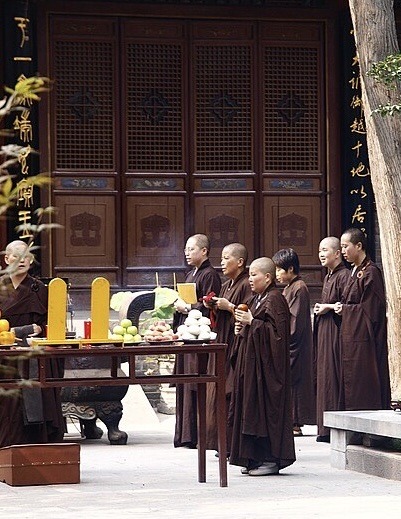
Nuns in Buddhism.
Buddhist nuns, called bhikkhunis, mostly live under disciplined & mindfulness. They share important vows, offer teachings on Buddhist scriptures, conduct ceremonies, teach meditation, offer counseling, & receive alms. Bhikkhunis are expected to go against the materialistic values, focusing instead on spiritual aims outlined by the Buddha. They adhere to specific precepts guiding their behavior/lifestyle, which vary based on tradition & monastery.
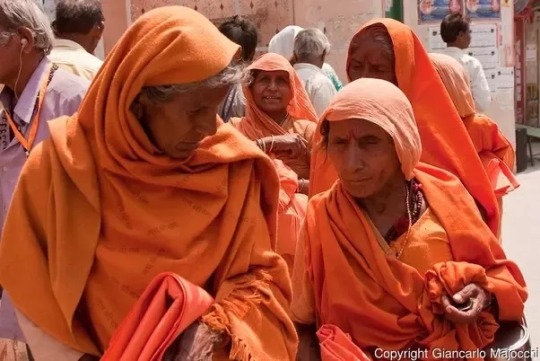
Nuns in Hinduism.
Hindu nuns, also called sanyasini, sadhavi or swamini, practice a monastic life of religious devotion by living simple lives of study, meditation & prayer. Some nuns seclude themselves in Hindu communities while others wander from place to place spreading the teachings of their faith, all their actions are directed as a service to Brahman. Hinduism teaches followers to respect these nuns for renouncing material things.
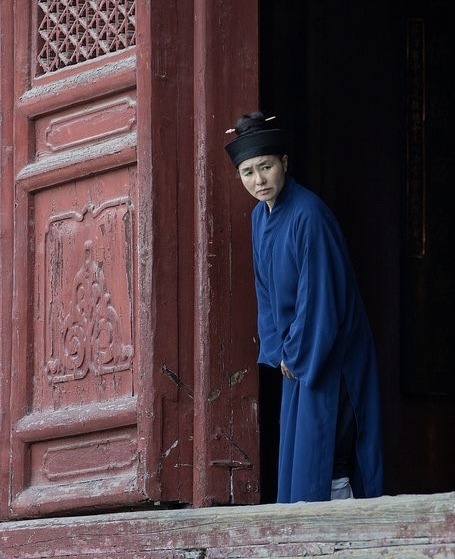
Nuns in Taoism.
Taoist nuns typically lived in temples known as guan, Celibacy was associated with early Taoist schools. They are solitary practitioners who take modesty & Clarity. In the Shangqing School, Taoist nuns are called nü daoshi or nüguan. their daily schedule included chanting scriptures, community work, and individual practices, including inner alchemical exercises.
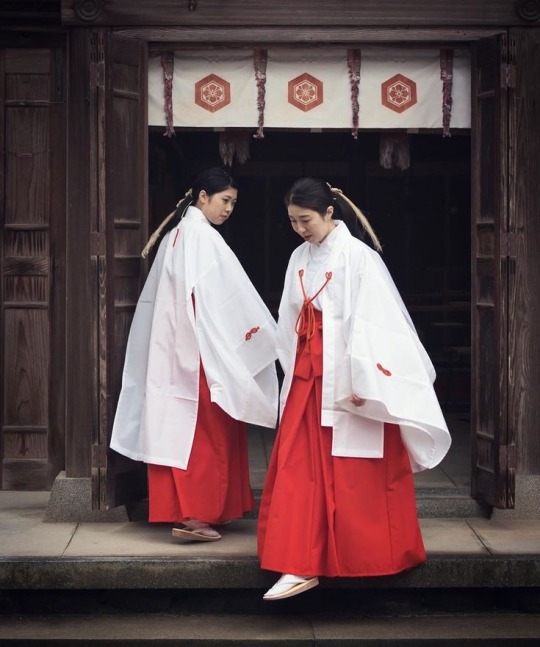
Nuns in Shintoism.
Shinto nuns are called miko, or shrine maiden, they’re young nuns who work at shrines & heavily worship Shinto Kami (gods). Miko were once likely seen as shamans & priestesses but they are understood in modern Japanese culture to have an institutionalized role in daily life, trained to perform tasks, ranging from sacred cleansing to performing the sacred Kagura dance.
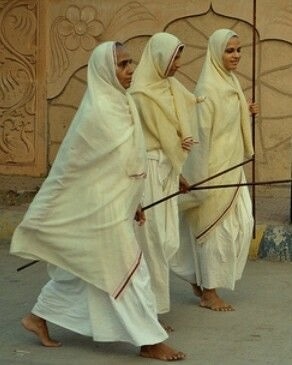
Nuns in Jainism.
Jain nuns are known as Aryika, or as Sadhvi. Aryikas (sadhvis) mostly meditate near Vrindavan, India. In Samavasarana of the Tirthankara, aryikas sit in the third hall. The Aryikas lead a simple life, with few possessions, and consider the world their family. They live in small groups and dedicate their days to meditation, study, carefulness & extreme compassion.
#religion#religions#nun#nuns#christianity#buddhism#hinduism#Taoism#Daoism#Shinto#shintoism#Jainism#bhikkhunis#bhikkhuni#sanyasini#sadhavi#swamini#nü daoshi#nüguan#miko#Aryika#desiblr#lotus-list
19 notes
·
View notes